Silent Sun Press can currently be reached at silentsunpress@gmail.com
A-to-Z Glossary of Terms
A
- acid-free — Acid (such as lignin found in wood-pulp paper) will break down a book, resulting in yellow and brittle paper or broken bindings. Acid-free adhesives, papers, and other materials are made to be used or stored for a long time without fading, discoloring, or falling apart. See: archival
- advance copy — In publishing, a free copy of a new book given by a publisher to someone for free before the book is printed for mass distribution.
- archival — material suitable for long-term use or storage; not inclined to yellow, fade, or fall apart. See: acid free
- asterism — a group of three asterisks (⁂) drawing attention to following text or dividing sections. Once used often, it is now fallen out of use, replaced by ungrouped asterisks (***) or other symbols.
- awl — a small pointed tool used for piercing holes in pages for sewn bindings
B
- back matter — The content after the main body text, including conclusions, appendices, bibliographies, glossaries, contributor lists, sources, suggested reading, colophon, afterword, or author’s notes
- backing — Fanning out and hammering the spine of the book to form joints or shoulders to fit the cover boards. All backed books are rounded first.
- bastard title, half-title — The recto of the first or second leaf of a book, on which is printed the brief title. It usually excludes the author, subtitle, publishing house, and other information.
- bleed — printing that goes beyond the edge of where the sheet will be trimmed
- blotter — a highly absorbent type of paper used to absorb moisture from writing material
- book block, textblock — The block of pages making up a book, excluding the binding.
- book bugs, bookworms — a general name for any insect that is said to bore through books. Booklice, termites, moths, and other pests eat materials used in bookmaking (paper, glues, leather) or mold that may be on a book. No true worms eat book materials, but the worm-shaped larval stage of beetles, moths, or roaches may have been called bookworms.
- book plate — A printed or decorative label pasted into a book
- bookboard, greyboard, binders board, museum board, davey board — The material used for the front and back boards of a book
- bookcloth — Book-covering material made from woven cotton, linen, silk, or other fabric. It is often backed or coated in some way to prevent adhesive from striking through to the front, to increase its durability or cleanability, or to allow it to accept decorative elements such as foil. Bookcloth is commercially available, and there are also methods of making it at home.
- broadside — a sizable sheet of paper printed on one side, or a work printed on a broadside
- buckram — Commercially available fabric made of cotton, linen, or a blend which is stiffened with gum or paste. May be water resistant.

C
- calico — Plain cotton or other even-weave, unbleached fabric. In the USA, calico is cotton printed with floral or other patterns, and what is called calico abroad is referred to as muslin.
- cap, head cap — In leather bindings, a shaped and modelled turn-in over the top and bottom of the spine.
- case binding — A binding method for hardcover books, where the textblock is prepared seperately from the cover, then the cover and textblock are attached to eachother.
- chapbook — Pamphlet bound or stapled single-section book, often for poetry or other short form literature
- coil binding, comb binding, spiral binding — Single Sheet binding method where a stack of papers are bound together with a spiral or joined line of plastic or wire rings
- codex — a book in the structural sense; a collection of seperate pages connected at a spine, as opposed to, say, a scroll
- collate — collating is putting all the imposed and printed pages in the proper order to be bound.
- colophon — an inscription in the book describing details about its design or production. Older books had the colophon in the back matter, and modern books may have it in the front matter. The location is a stylistic choice.
- colorfast — As in bookcloth or paper, dyed in such a way that the color will not bleed or run, even when exposed to moisture such as glue.
- coptic binding — A binding method which involves hard covers sewn to the first and last signatures, an exposed spine, and chain link stitching. Coptic binding is non-adhesive, and does not require any glue in its construction. A coptic bound book opens completely flat, making it ideal for sketchbooks .
- copy — The text, as written by the author, that is to be typeset. Written material, but not images or other elements of layout
- cradle — A piece of equipment used by bookbinders to hold and accurately pierce sewing stations along the spine of a signature.
- crash — An open-weave cotton cloth stiffened with starch to facilitate handling. It is used as the first lining on the spine. See: Mull, super, scrim.
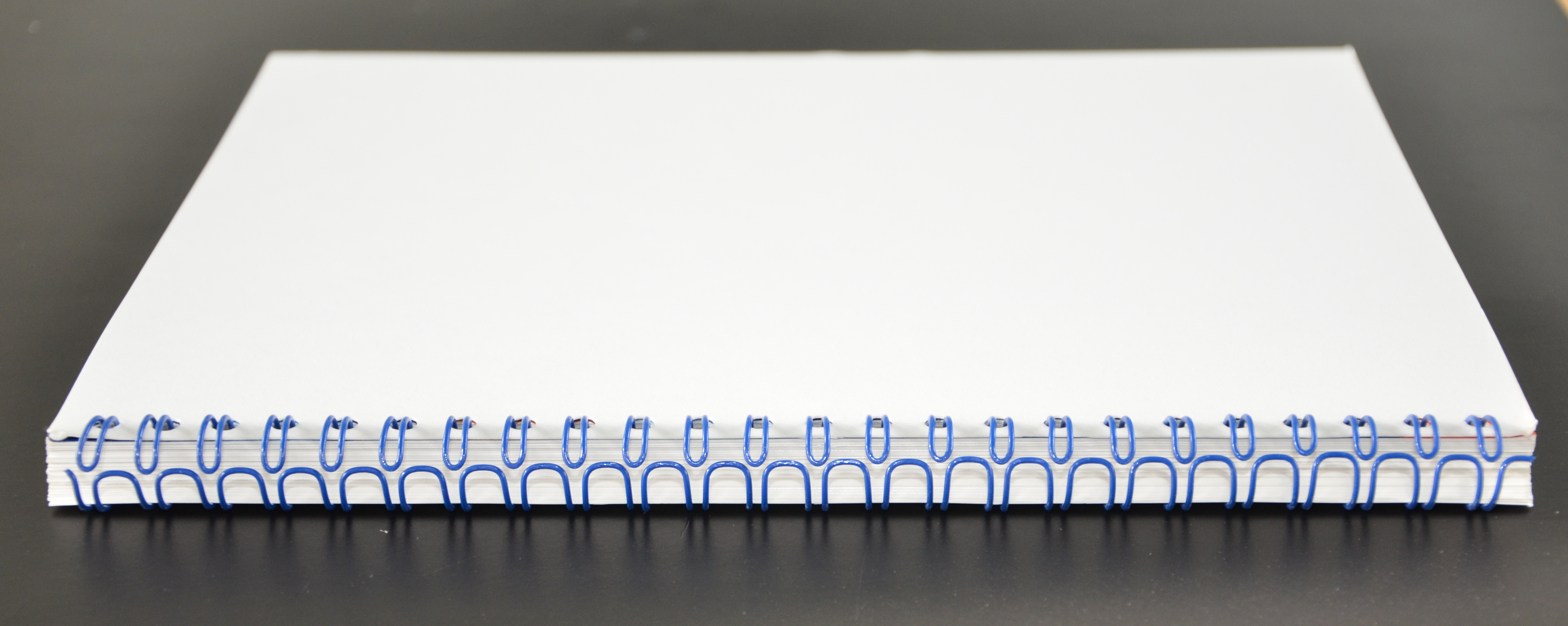

D
- daylight — The amount of light visible through a book press when fully opened. More daylight space will allow more and larger books to be pressed at one time.
- debossing — stamping a design or lettering onto a surface so it is permanantly indented.
- deckle edges — broken fibrous edges of paper left from the papermaking process. Or, stylistically, torn edges of paper rather than cleanly cut. Deckle edge books may not have been trimmed open at the fold, requiring them to be cut open by the connsumer to be read.
- dingbats — An ornament or glyph used to add decorative elements or as a dinkus to divide sections. Also, a computer font that has symbols and shapes
- dinkus — A typographical symbol, such as a triple asterisk, flourish, or horizontal rule, used to indicate a section break. Historically used to indicate omitted material, and still used this way in legal writing.
- dos-a-dos binding — two textblocks cased back-to-back, with each having its spine at the others foreedge, both books sharing one back sandwiched between them. Both books are upright to each other, sharing a head and tail. The outside of the book is only front cover.
- double fan binding — A type of glue binding where single sheet pages are fanned out at an angle on the spine-edge of the book, and adhesive is brushed on. The pages are then fanned out in the opposite direction, and the adhesive is applied again. Stronger than other types of perfect-bound books.
- DPI, PPI — PPI (Pixels per inch) describes the resolution in pixels of a digital image. DPI (dots per inch) describes the amount of ink dots on a printed image.
- drop cap — A large capital letter used as a decorative element at the beginning of a paragraph, chapter, or section
- duplex — Printing on both the fron and the back of a sheet of paper. This may be automatic, or manual in a home printer.
- dust jacket — A detachable outer cover, usually made of paper and printed with text and illustrations

E
- embossing — stamping a design or lettering onto a surface so it is permanantly raised
- endbands/headbands — coloured threads entwined tightly round a core of vellum backed with leather, and traditionally sewn through the sections. Modern decorative endbands are glued into the spine. The band at the tail of the book is sometimes called the tailband, the band at the head of the book is called the headband, and both head and tailbands are collectively referred to as endbands. Glue-in endbands are commercially available.
- endpapers — Usually decorated, these papers are the first and last pages of a book, and are used to attach the text to the cover. The endpaper becomes the pastedown and the first free flyleaf.
- endsheets — These are the blank papers at the start and end of the book.
- Epigraph — A phrase, quotation, or poem separate from the work included at (usually) the beginning of a book.
- EVA — a polymer-based adhesive, (Ethylene-Vinyl Acetate) sometimes called hot-melt glue, which is acid free, non-toxic, and sometimes heat-reversible.
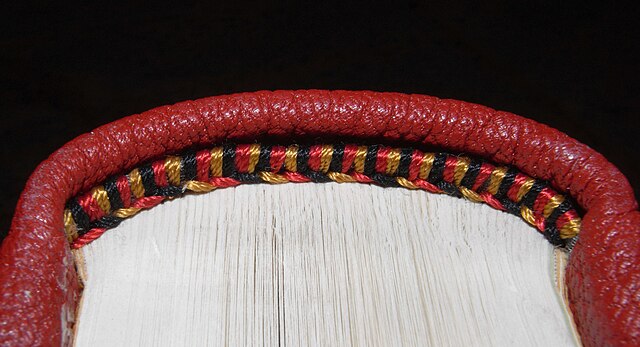
F
- filling in — The operation of filling in the space on the inside of the front or back board left uncovered by the cloth or covering material with pulp or manilla card. This levels the surfaces so that the endpapers lie flat.
- fixative — A spray used by artists on dry media to stabilize the pigment, protect a work from dust, and prevent smudging or smearing. Some decorative papers for covers or endpapers my need fixative to keep from staining the book or books touching them.
- flatback, square back — A book which has not been rounded and backed before the boards are attached
- flyleaf — a blank leaf in the front or back cover
- folder, bone folder — A semi-flat, polished tool traditionally made of bone or ivory, but now also available in palstic or teflon. Used to score, flatten folds or smooth paper in a single stroke without marring delicate papers
- folio — A sheet of paper folded once to give two leaves (4 pages). Also, a book made of such sheets, i.e. the largest format possible in that particular size.
- font — A complete character set in a particular point size, in a particular typeface. Colloqially used interchangably with typeface. "Garamond" is a typeface, while "Adobe Garamond", "Cormorant", and "ATF Garamond" are fonts in the Garamond typeface. See: typeface
- footer — The standard text that appears on the very bottom of every or every other page, for example, a page number,
- fore edge — The front edge of a book, opposite the spine
- front matter — The preliminary pages of a book, comprising the half-title page, the frontispiece, the title page, the imprint page, the contents page and any other pages up to the beginning of the main text. They often form the first section. In old books these pages are usually numbered with Roman numerals
- frontispeice — The illustration facing the title page of a book
- full-binding, whole binding — The cover of the book is made wholly from a single material. Often the term is used specifically to refer to leather covered books.
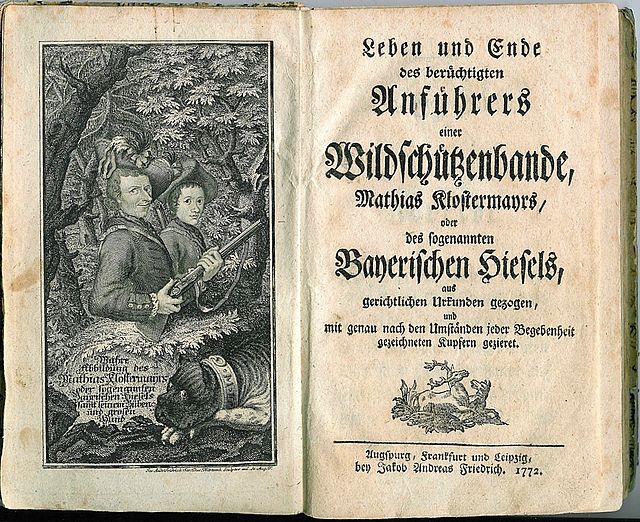
G
- gilt edge — the application of gold leaf (or modern faux gold foil) to the edges of the leaves of a book
- glued binding — A binding made of single sheets stuck together at the back with glue or paste, not sewn
- grain — the orientation of the fibres in paper and board, or of the warp thread in cloth. The grain will nearly always run from head to tail of the book. Grain direction effects the way material tears, or warp or curls especially when wetted.
- guillotine — A tool designed to administer straight cuts to single sheets or large stacks of paper at once
- gutter — The white space or inner margin visible when a book is opened to any page. If the book is opened to a signature, sewing thread may be visible running along the gutter.
H
- half-binding — A style of binding where the spine and corners are covered with a high quality or strong material (for example leather) and the rest of the cover is a cheaper or weaker one like paper. see: quarter-binding
- head — the top edge of a binding or page
- header — The standard text that appears on the very top of every or every other page; for example: book title, author, chapter title, page number, etc. Academic or scientific writing will have standardized expectaions for what to put in a header, but in fiction or general non-fiction, it is a stylistic choice.
- hinge — The flexible inside area between a book’s covers and spine, allowing the book to open and close easily. See: joint
- hollow — A paper tube stuck to the spine of a book, to which the covering material is attached. The resulting hollow back allows for books to open more freely.
- hollowspine — A spine where the covering material is not attached directly to the spine of the sections, allowing the book to flex open more easily

I
- impose — The method of arranging the pages of the document so that they are in the correct sequence when the sheet is printed and folded.
- imprint — A trade name under which books are published and distributed.
J
- joint — The flexible outside area between a book’s covers and spine, allowing the book to open and close easily. See: hinge
- justification — When text is aligned along the left margin, with letter-spacing and word-spacing adjusted so that the text falls flush with both margins, also known as fully justified or full justification
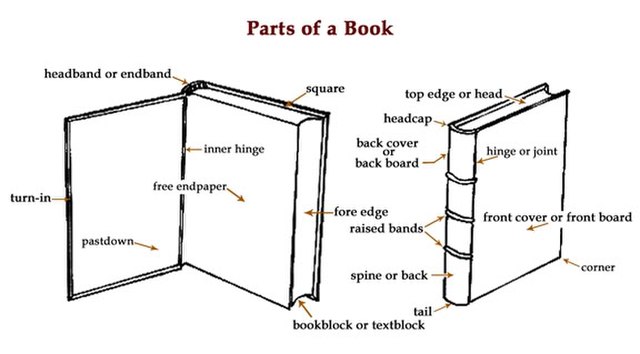
K
- kerning — the spacing between specific letters or characters
- kettle stitch — A catch stitch or knot made at the end of each section to join it to the preceding one
- kozo — Long-fibered, strong paper from Japan
L
- laminated — Two or more materials stuck together in layers.
- leading — the space between multiple lines of type
- leaf — two pages of text, front and back
- library binding — A utility binding incorporating structural differences that give strength and durability, such as sewn-on tapes, reinforced endpapers and a thick leather cover. It normally has a tight back, and its main feature is the French groove.
- ligature — Two or more characters or letters joined to form a single glyph
- limp cover — A soft cover, very often with both squares extending over half the thickness of the book, thus enclosing the edges of the pages. Bibles are often limp bound.
- lining — 1. Pieces of strong paper pasted to the inside of boards to prevent their being warped by the covering material. 2. material used to strengthen the spine, mull
- link stitch, french link — The sewing together of two or more sections without tapes. Each section is linked to the rest by catching up the loops of thread of the preceding section.
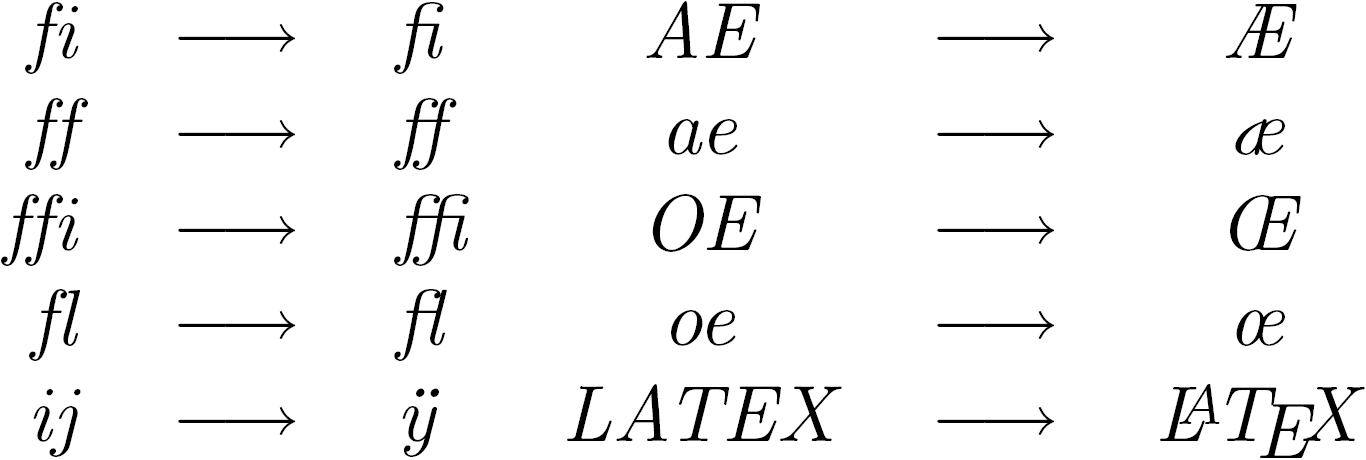
M
- margin — The edge or border of each page, left white. Margins prevet text from being cut away during trimming, provide a place to hold the book without covering up text, and allow for whitespace to visually balance the printed portion of a page.
- methyl cellulose — A water-based adhesive that is non-toxic, acid-free, and sometimes reversible.
- moisture barrier — A sheet of something non-absorbant, such as plastic, placed between the textblock and a place being glued to protect it.
- Mull — An open-weave cotton cloth stiffened with starch to facilitate handling. It is used as the first lining on the spine. See: super, crash, scrim.

O
- octavo — A sheet of paper of any traditional size, folded three times to make a section of eight leaves. Or, a book in this size.
- open spine — A book where the binding method has not covered the spine of the book, allowing the bookblock and any sewing to be seen, such as in Coptic binding.
- Orphan — A single word (or syllable) that sits at the bottom of a paragraph of text, or the first line of a new paragraph that sits on its own at the bottom of a column of text. See: widow
- overcast — Reinforcing a section, or joining a number of single sheets together, by sewing through the back margin
P
- page — One side of a leaf or sheet of paper
- parchment — Sheep or goatskin (with the hair removed) that has been split, soaked, limed and dried under tension, not tanned like leather
- paring — The process of thinning leather.
- Paste, starch paste, wheat paste — A natural, reversible plant-based adhesive created by cooking a mixture of wheat flour or similar and water over heat for a specific period of time.
- perfect binding — A style of binding where single sheets are glued together at the spine to form a textblock. All the pages and the cover are cut perfectly flush with each other. All paperbacks are bound in this style. Many mass-produced hardcover books are perfect bound before being cased.
- plate — Diagrams and illustrations printed on different paper from the text and bound either with the text or tipped in as separate leaves or sections
- plough, plow — A piece of equipment with a sharp blade used to trim the edges of a book. A plough usually comes with a tub where trimmings can be captured as they fall away. In commercial bookmaking, this has been replaced by the paper guillotine, but it is still used by craft bookbinders and in fine binding.
- PVA — A water-based adhesive (poly vinyl acetate) that is non-toxic, acid-free, dries clear and remains flexible. White Glue

Q
- quarter-binding — A style of binding where the spine and corners are covered with a high quality or strong material (for example leather) and the rest of the cover is a cheaper or weaker one like paper. See: half-binding
- quarto — A sheet of paper folded twice to make four leaves. Also, a book made in this size.
R
- recto — the right-hand page in a book and is usually numbered with an odd page number. When typesetting in most softwares, the first page of your document will be the recto. In languages that read right-to-left, these are reversed. See: verso
- register ribbon — A built in bookmark made of ribbon attatched at the head of the spine.
- rounding — Shaping the spine of the book into a convex shape. Most (but not all) rounded books are also backed.

S
- saddle stitch — Securing the leaves of a single section with a staple most often, but sometimes by sewing with thread or inserting wire through the back fold. Most comics or magazines are saddlestitched
- sawtooth — The un-uniform foreedge of a textblock caused by the folding of pages into signatures. This may be trimmed away for a smooth edge, or left as a stylistic choice.
- scrim — An open-weave cotton cloth stiffened with starch to facilitate handling. It is used as the first lining on the spine. See: super, crash, mull.
- sewn binding — A binding made up of sections sewn together. A sewn binding may also be glued on the spine; but some bindings, such as stab binding or coptic binding, are completely adhesive free.
- sextodecimo — A page printed and folded into sixteen leaves (thirty-two pages). Also, a book in this size.
- shoulder — The raised edge of the textblock spine after backing, where the boards will fit when cased.
- signature, section — a sequence of pages folded over each other to form a section of a bound book. Sometimes called a quire.
- Smythe sewing — text sewn through holes or slots in the fold of the signature, as opposed to overseen or stab-bound books. Stitches used in Smythe sewing include kettle, link, and long stitch.
- spine — The edge of a book along which the leaves or sections are fastened together in binding
- square — The space between the boards or covers of a book and the textblock.
- stab binding — A method of binding single sheet together by sewing on a wide margin up the spine. The stitches can be plain, but decorative patterns can be made as well. It produces a book that does not open flat. Stab binding does not require the use of glue.
- stationery binding — Used for binding blank-leaved books intended to be written in, e.g. ledgers, account books, diaries. Kits with all the material you need to bind a stationery book are available commercially.
- straight page — A file or PDF of the contents of a book with all the pages in numerical order, before being imposed for folding
- super — An open-weave cotton cloth stiffened with starch to facilitate handling. It is used as the first lining on the spine. See: crash, mull, scrim
- swash — a typographical flourish on a letter or character, such as an exaggerated serif, terminal, tail, entry stroke, etc
- swell — The additional thickness in the sewn folds of the sections, caused by the sewing thread and air space between folded leaves.
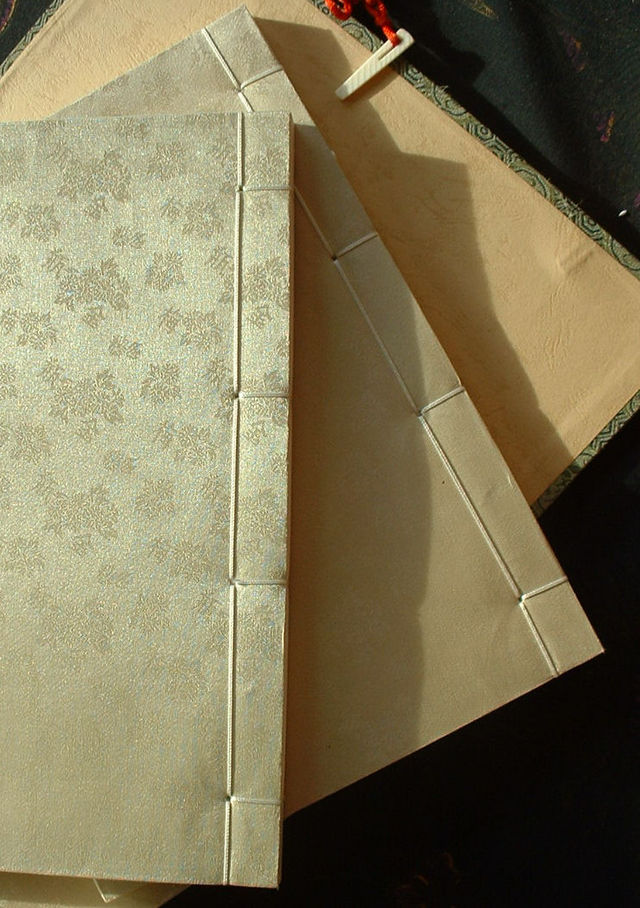
T
- tail — The bottom of a binding or page
- tapes — linen or other material used as a sewn support in bookbinding
- tête-bêche binding — Two textblocks bound together sharing a spine and foreedge, so each's head is the other's tail, making them upside-down to each other. There is no back cover: both sides are the front cover of one book.
- tightback — A spine where the covering material, usually leather, is attached directly to the lined or unlined spine of the sections.
- tipped-in — To incorporate a single sheet, plate, endpaper or section into a book by applying a narrow strip of adhesive to its back margin and sticking it to the back edge of a section
- title — The recto of the third or fourth leaf of a book, on which is printed the complete title of the book, with other information such as author, volume number, date, patron, publisher's name, and place and date of publication
- turn-ins — The part of the covering material which is turned in over the edges of the boards to protect them and for looks
- typeface — a design of letters, numbers and other symbols. A typeface may be veiwed as a 'font family' and can include variations of itself. "Garamond" is a typeface, while "Adobe Garamond", "Cormorant", and "ATF Garamond" are fonts in the typeface. See: font
- typesetting — The process of converting copy from a word-processing document into a professional-looking file that you can use for printing. The art of arranging text on a book page
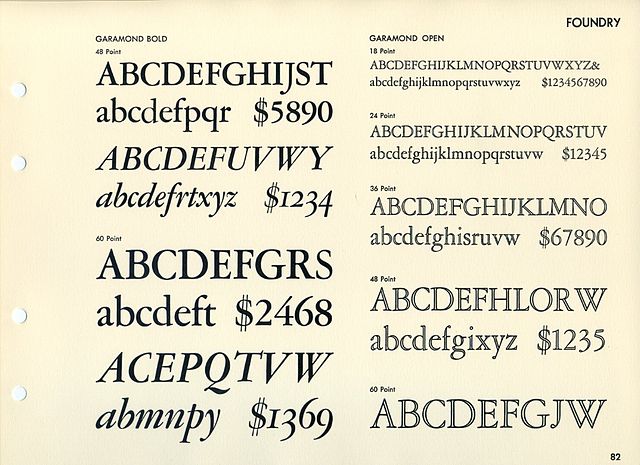
V
- vellum — Calfskin (with the hair removed) that has been soaked, limed and dried under tension, not tanned like leather.
- verso — the left-hand page and is usually numbered with an even page number. In languages that read right-to-left, these are reversed. See: recto
W
- waste sheet — A protective sheet of paper incorporated in the endpapers and either cut down or removed during binding
- widow — A paragraph-ending line that falls at the beginning of the following page, separated from the rest of the text. See: orphan
- wrapper — The covers of a binding that has no boards
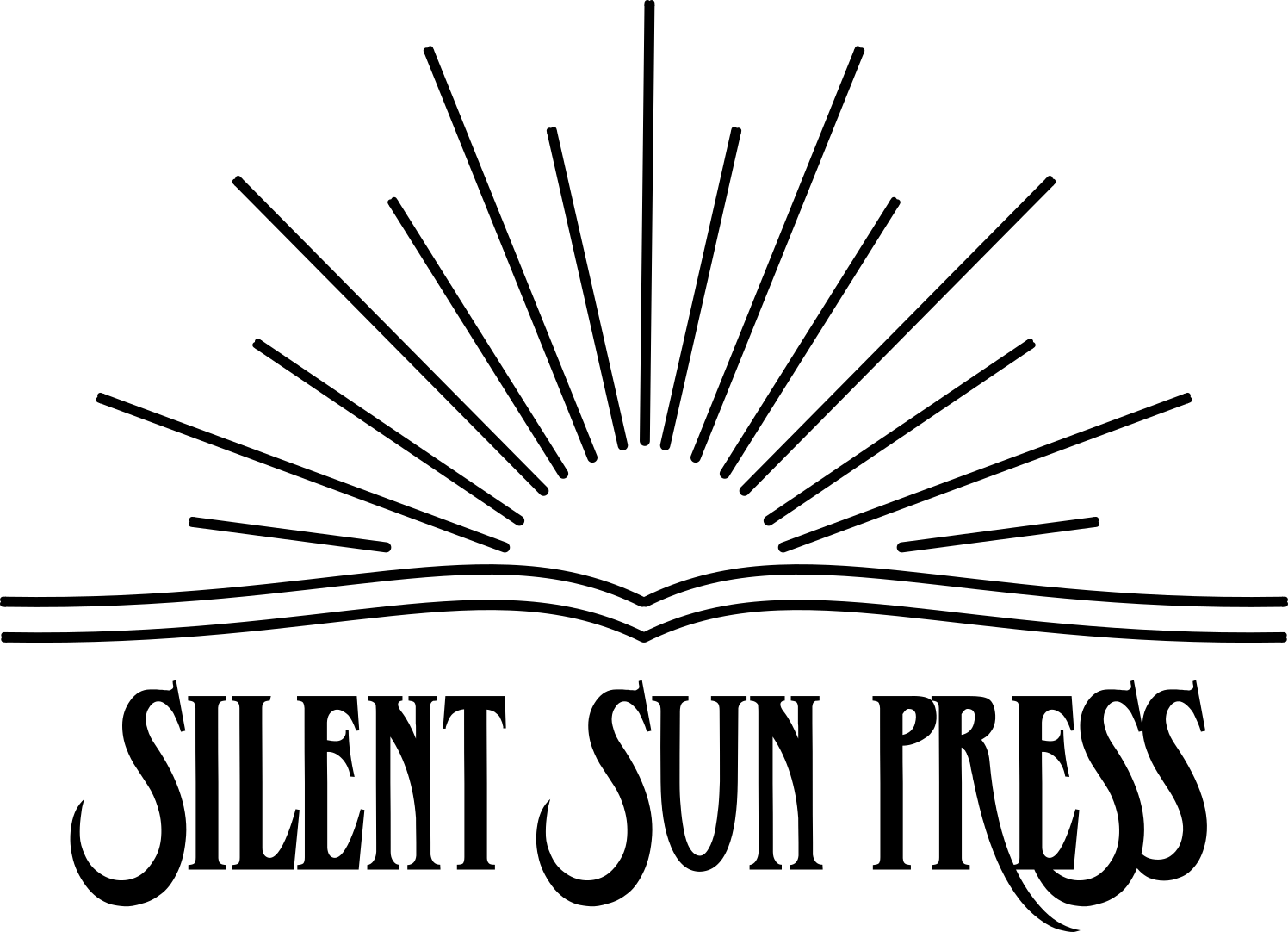 © Layout by
© Layout by